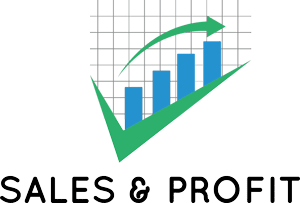Table of Contents
Sales prospecting is really important part of a sales process, but being a sales professional myself, I know it’s not easy.
You have to talk to a lot of prospects just to get that one meeting, and not everyone is going to be interested.
In 2024, simply using cold calling or sending hundreds of emails isn’t as effective anymore.
You have to put in that extra effort to get more qualified leads from your sales prospecting.
So with practice and the right sales prospecting methods, salespeople can get better at this and get more leads.
Let’s look at 16 effective sales prospecting techniques in this blog
Sales Prospecting Methods for Cold Calling
1. Research Your Prospect Before Calling
Before you pick up the phone, invest time in researching your prospect.
Understand their business, industry challenges, and potential needs that your solution can address.
This preparation allows you to tailor your conversation and quickly establish relevance.
Study the following to know more about the Company :
- Website.
- Their offerings.
- Annual & financial reports.
- Their key decision-makers.
- Their competitors you have worked with.
- Any recent news/updates that might indicate a need.
Study the following to know more about the Prospect :
- Their LinkedIn profile.
- Roles and responsibilities.
- Any mutual connections.
- Any past interactions.
By researching the prospect, you can have a better conversation starters and tailor your pitch accordingly.
2. Focus on Making Warm Calls
What’s a warm call? Oppose to cold calls, warm calls targets prospects who are familiar with you and your company.
Before directly cold calling sales prospects, it is always an advantage for sales reps if they already know you and your company.
Before making the first call, you can make the prospect warm by doing the following :
- Send a personalized LinkedIn connection request.
- Engage with their content on social media more often.
- Send a cold email first before calling.
- Try to get a referral from mutual connections.
Apart from the salesperson trying to warm up the prospect, you can check if the prospect have previously interacted with your company.
To find if the prospect have interacted with your company before, you can look for :
- Your CRM to track any past interactions.
- If they had inquired on your website.
- If they engaged on your social media.
- If they attended past webinars/events.
- If they have downloaded any content from website.
- Any past sales proposals sent.
3. Maintain Optimal Talk-to-Listen Ratio
One of the most common pitfalls talented B2B sales reps make is dominating prospect calls with constant pitches of their solution.
Having observed hundreds of client calls over decades, I cannot stress enough on resisting this urge especially in initial meetings.
The best prospect conversations entail letting prospects do majority of the talking first.
According to a report by Crunchbase, successful cold calls have a Talk-to-Listen ratio of 55:45.
Here are some tips to maintain an Optimal talk/ Listen ratio.
Ask Open-ended Questions: Prepare a list of open-ended questions that encourage the prospect to speak about their needs, challenges, and priorities. Questions that start with “How”, “What”, “Why”, or “Tell me about…” are great for opening up the conversation
Follow the 55/45 Rule: Aim for the prospect to speak around 45% of the time while you speak for about 55%. This ratio ensures that you’re gathering enough information while still guiding the conversation with your insights and value proposition.
Use Silence Strategically: Don’t feel pressured to fill every pause. Sometimes, silence encourages the prospect to elaborate further.
Summarize and Reflect Back: Periodically summarize what you’ve heard and reflect it back to the prospect for confirmation
Be Mindful of Your Speaking Speed: Speaking too quickly can overwhelm your prospect, while speaking too slowly may bore them.
4. Craft Impactful Opening Statement
You only have 7 – 10 seconds before the prospect’s decides you are worth talking to.
So in the limited attention spans prospects afford, it is vital for sales reps to capitalize on the small opening window with an impactful opening sentence.
So what’s should an impactful opening statement have?
A Trigger.
A trigger is something you observed at prospect’s end which tells you they might have a need for your kind of solution.
Examples of good opening statements
- I noticed you’re looking for a new [specific role]
- Hi [Prospect’s Name], I saw the announcement about your [new product launch/partnership]
- Congratulations on your recent funding round, [Prospect’s Name]
5. Confirm Next Steps Before Wrapping Calls
Seasoned B2B sales professionals emphasize confirming specific follow-up actions before closing prospect calls instead of generic promises to reconnect later.
Mapping out next milestones – be it scheduling next discussion or sending proposals for evaluation, brings clarity on go-forward cadence for both parties post calls.
If you’ve agreed to setup a follow up call, immediately send a calendar invite for the follow up call.
Personally I follow a practice to also send a MoM post call to make sure the prospect is aligned with the discussing.
By never taking follow-ups for granted and always buttoning up prospect interactions with clearly defined next steps, sales professionals reduce delays, improve clarity and stickiness throughout the buy cycle.
Sales Prospecting Methods for Cold Emailing
6. Find a Trigger to Send Cold Emails
As mentioned above, a trigger is something you noticed at prospect’s end which tells you they might need your solution.
It should answer “Why” you are reaching out to this prospect.
Usually you should put your trigger statement at the start of your cold email.
Since cold emails is overused in sales, and your prospect already receives 100s of emails.
Using a trigger in your cold email will help you differentiate from the rest.
It tells the prospect that this salesperson has done some research on them before reaching out.
Here are some of the triggers you can use in your cold emails :
- Headcount Increase / Decrease
- Using specific Tech
- Department Growth
- Job Openings
- Hiring announcements
- Leadership changes
- Bad Product Reviews
- Bad employee Reviews
- Geo Expansion
- Company Performance
- Website Changes
- Leadership Changes
- Product Updates
- Funding / Investments
- Downloaded your content
- Attended your webinar
- A challenge you have seen in similar companies
There can be more triggers apart from these depending on your solution, industry and target prospects.
Examples of trigger statements:
- Hi Firstname, I noticed you are hiring for [Position Name]
- Hi Firstname, I saw your [Department Name] is growing
- Hi Firstname, While speaking with [Designation name] of other [Industry] companies, we saw [mention the challenge]
7. Personalize Cold Emails Using Frameworks
Usually sales reps follow a copy paste template while cold emailing.
But the problem with templates is – It looks like a generic and automated email with no personalization,
But following a framework will allow you to personalize your email for each account and prospect.
Here is a cold email framework we at Sales & Profit usually follow :
<Hi First Name>
<Your Trigger Statement>
<A Problem You Believe the Prospect is Facing>
<Your Solution to the Problem>
< A CTA Asking if They Are Interested >
Here are some examples of cold emails created using this framework
Example 1
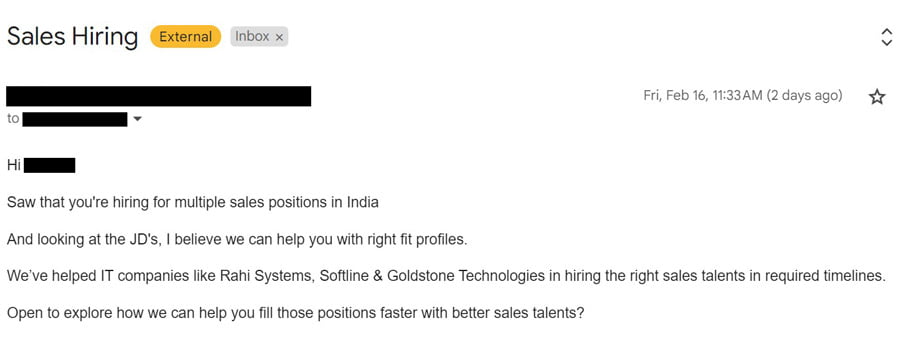
Example 2
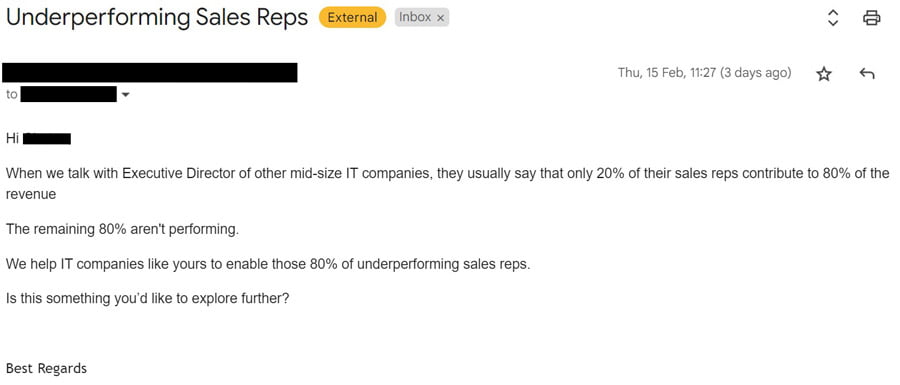
Example 3
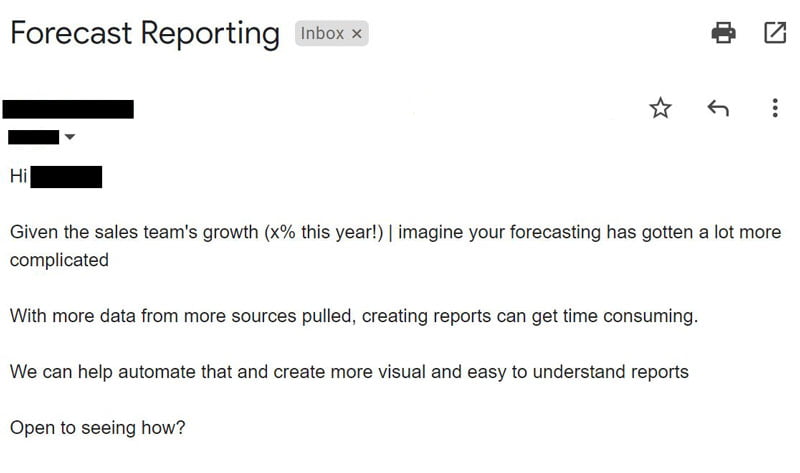
The content in this framework can be unique to each accounts or different decision makers in that account.
Here are some examples of cold emails we created using this framework
- More personalized emails.
- Content will be unique to each accounts or decision maker.
- Your email length will be in check.
- Your email will be more about your prospect and not you.
- Your email will stand out from other generic emails.
- Overall you’ll have a higher response rate.
8. Always Send Follow Up Emails
Sending just one email and stopping is a big mistake sales rep makes.
Though your first email is the most important one, not every prospect will reply on it.
SalesHandy says that sending 3 follow up emails can increase the response rate by 28%
Also Woodpecker says that sending 2-3 follow up emails is an optimal number.
So to get the maximum responses from your email campaign, doing 3 follow up emails is something sales reps should follow.
Here is how your email cadence can look like :
Day 1 – First Email
Day 5 – Follow up Email 1
Day 8 – Follow up Email 2
Day 11 – Follow up email 3
9. Send Multi-Touch Campaigns
A multi-touch campaign is reaching out to your target audience through various communication channels in combination with cold email.
For Example – You can combine cold email with LinkedIn message and cold calls.
Each channel reinforces messaging from the others for higher retention.
This can increase your chance of booking a call with the prospect.
The best way to leverage multi touch campaign is – To refer back to the previous channel.
Example of a multi touch campaign
On Day 1 – Send a connection request on LinkedIn.
On Day 3 – Send 1st cold email
On Day 3 – Send a LinkedIn message restating what you said in the cold email and referencing that you had dropped an email with XYZ subject line
On Day 5 – Follow up email
On Day 7 – A Cold call referencing about your cold email and LinkedIn connection.
Sales Prospecting Methods for Social Media
10. Become a Thought Leader
Though being a thought leader will not actively generate leads for you, in the long run prospects will be more open to discuss if you reach out.
With social media usage growing exponentially for lead generation, sales professionals cannot ignore leveraging their clout on these platforms, especially LinkedIn which is more business-focused.
The best way to establish yourself as a thought leader is – Creating education content that directly addresses your target audience’s challenges.
By consistently sharing such content, your audience will perceive you as a subject matter expert.
11. Use LinkedIn to Target Right Decision Makers
As you may already know, LinkedIn is a platform for targeting the right decision-makers in enterprise sales.
To find the right prospects, you can either use the basic filters available in the free version.
Or pay for LinkedIn Sales Navigator to get much more detailed targeting options.
With LinkedIn Sales Navigator, you get the “Advanced Search” feature to search for leads and accounts using combination of search criteria’s.
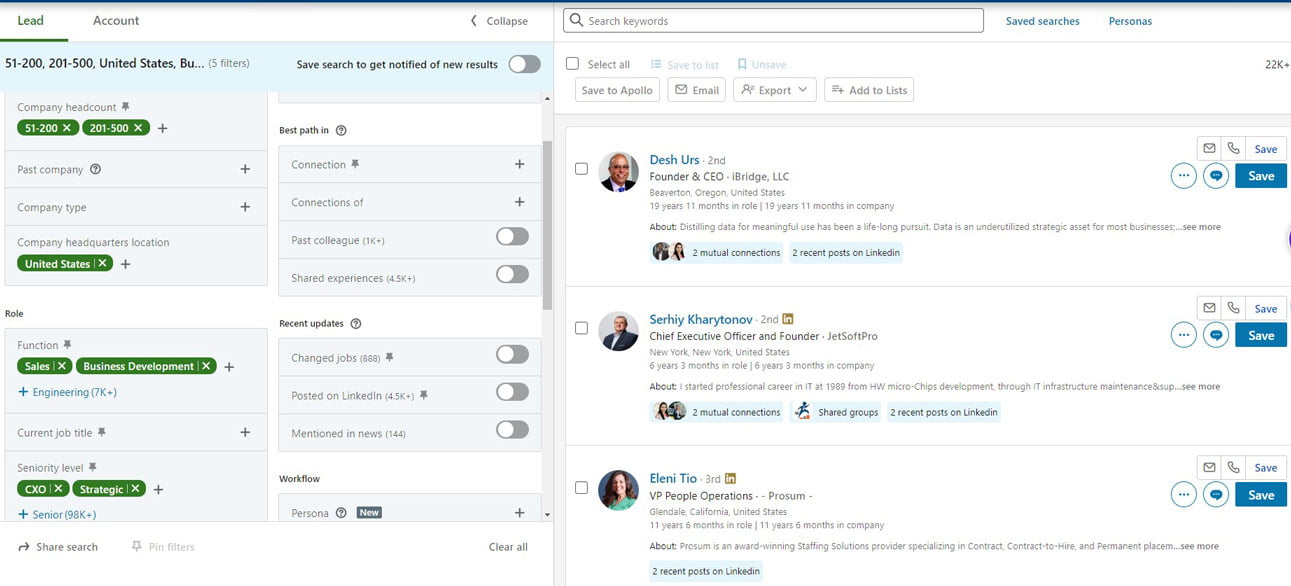
In LinkedIn Sales Navigator, you can also save prospects into a separate list, and you can also create search criterias in which LinkedIn will keep on adding new prospects.
12. Connect With the Prospects on Linkedin
There are over 1 billion users on LinkedIn, so it’s a no brainer your prospects are present there if you are in B2B sales.
Just like email you should also connect with your ideal prospects on LinkedIn.
Your goal is to start a conversation, not to pitch.
You can use a this framework to send LinkedIn messages :
<Trigger – Why you are reaching out>
<A Problem – What problem you feel they might be facing>
<Asking a Question – Asking how they are currently managing things>
Linkedin Message Example 1 :
“I noticed your company’s recent expansion into new markets, congratulations on that significant achievement!”
Expanding teams often face challenges in maintaining efficient sales processes, which can impact growth momentum.
How are you currently managing the integration of new sales territories into your existing processes?”
Linkedin Message Example 2 :
“Your leadership in adopting sustainable practices within supply chain management is truly commendable.”
However, sustainability efforts often bring to light inefficiencies in supply chain operations that many hadn’t anticipated.
What have been the biggest hurdles in streamlining your supply chain for sustainability, and how are you overcoming them?”
Other Sales Prospecting Methods
13. Attending Networking Events
Networking events are a great way to meet potential customers and build relationships without directly selling.
Here are the steps you can follow to make the most out of these networking events :
- Research the Event – Understand the nature of the networking event, the participating companies, and the key decision-makers who are likely to attend.
- Set Clear Goals – Define what you aim to achieve from the event, such as the number of new contacts, potential leads, or specific companies you want to connect with.
- Prepare Your Elevator Pitch – Develop a concise and compelling elevator pitch that clearly communicates your value proposition under 30 seconds.
- Listen Actively – Focus on understanding the challenges and pain points of the individuals you meet, and how your solutions can address them.
- Share Insights, Not Sales Pitches – Instead of pushing a sales pitch, offer valuable insights or industry knowledge that can help establish your expertise and build trust.
- Send Personalized Follow-Up – Reach out to the contacts you made, referencing your conversation and expressing your interest in continuing the discussion. You can connect on LinkedIn or emails.
14. Getting More Referrals
When a satisfied customer refers you to their network, it shows that they trust your product or service.
Also referrals helps you bypass the initial stages of prospecting, as the referral source has already vouched for your company.
Being a Co-Founder of Sales & Profit, I can tell you from my own experience that getting referrals is very important.
Recently for our sales consulting service, many of the customer’s we have onboarded has come through reference.
And its much easier to close such leads when compared to leads coming from cold prospecting.
15. Hosting Regular Webinars
Webinars are great medium to demonstrate your knowledge and thought leadership in your industry.
Overtime you’ll build an audience who are already interested in a niche you are operating in.
From our experience of hosting several webinars since past 2 years, we’ve seen that regular webinars helps you create a brand awareness in your target market.
And whenever we reach out to the attendees, they recollect our brand name as they had attended our webinar.
(Check out our recent webinars here)
Here are some steps to generate more leads from webinars :
- Define your target audience – Start by defining the ideal attendees for your webinar as the first step. This will help you choose topics that matters to them the most.
- Choose a compelling topic – Select a topic that is relevant and interesting to your audience. Your topic should also address a challenge you feel they might be facing.
- Promote your webinar – Use a variety of marketing channels to promote your webinar, such as email, social media, and paid advertising.
- Create a strong registration page – Make it easy for potential attendees to register for your webinar by providing a clear and concise registration page.
- Redirect them to a sales page – This is something we follow at Sales & Profit. After the attendees have registered for the webinar we redirect them to a sales page which offers them something for free in exchange for their details like – A free consulting call, a downloadable document or checklist or links to your other free resources.
- Focus on content quality – Develop a well-structured and engaging presentation that covers the topic in depth and provides value to your audience.
- Engage with your audience – Encourage audience participation by asking questions, conducting polls, and allowing time for Q&A sessions.
- Record and repurpose your webinar – Record your webinar and repurpose the content for other marketing channels, such as blog posts, social media, and email campaigns.
- Follow up with attendees – Follow up with webinar attendees with the webinar recording and with additional free resources as mentioned in point 5.
16. Take Advantage of Tools
You can use many tools to improve your sales prospecting efforts and generate more leads.
Here are some steps to generate more leads from webinars :
- Sales Intelligence Tools – These tools provide insights and data on potential customers, such as their contact information, company size, industry, and more.
- Email Automation Software – These tools help sales professionals send personalized and targeted emails to potential customers. For B2B cold emails, we recommend using a tool that allows sending plain text emails and follow ups in same thread.
Example tools – Snov.io, Instantly.ai, Lemlist, Woodpecker.
- CRM Software: Customer Relationship Management (CRM) software helps sales professionals manage their customer interactions and track the progress of their sales pipeline.
Examples tools – Salesforce, HubSpot, Zoho CRM.
- Visitors Tracking Tools – These tools tracks visitors from which companies have visited your website. Though it doesn’t give the individual’s details. It tracks the company name from which visitors belong, so you can target those accounts.
Examples tools – Factors.ai, Leadfeeder, Lead Forensics.
- Buying Intent Tools – These tools provide insights of potential customers’ online behaviour, allowing you to identify those who are actively searching for products or services like yours.
Wrapping Up
In conclusion, mastering sales prospecting is key to finding and connecting with new customers effectively.
By moving beyond traditional sales prospecting methods, sales reps can use targeted, thoughtful strategies to reach potential customers in ways that are more likely to get their attention.
To enable your sales team to do effective prospecting, organizations would often require to invest in sales training programs.
It’s about understanding who your potential customers are, what they need, and how your product can help them.
Using the sales prospecting we’ve covered can open up new opportunities and help grow your sales.
